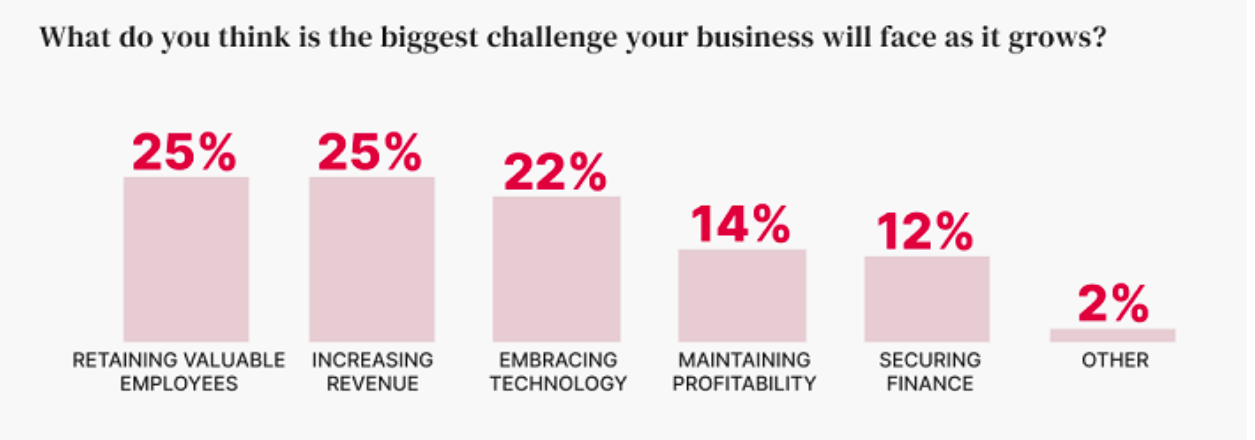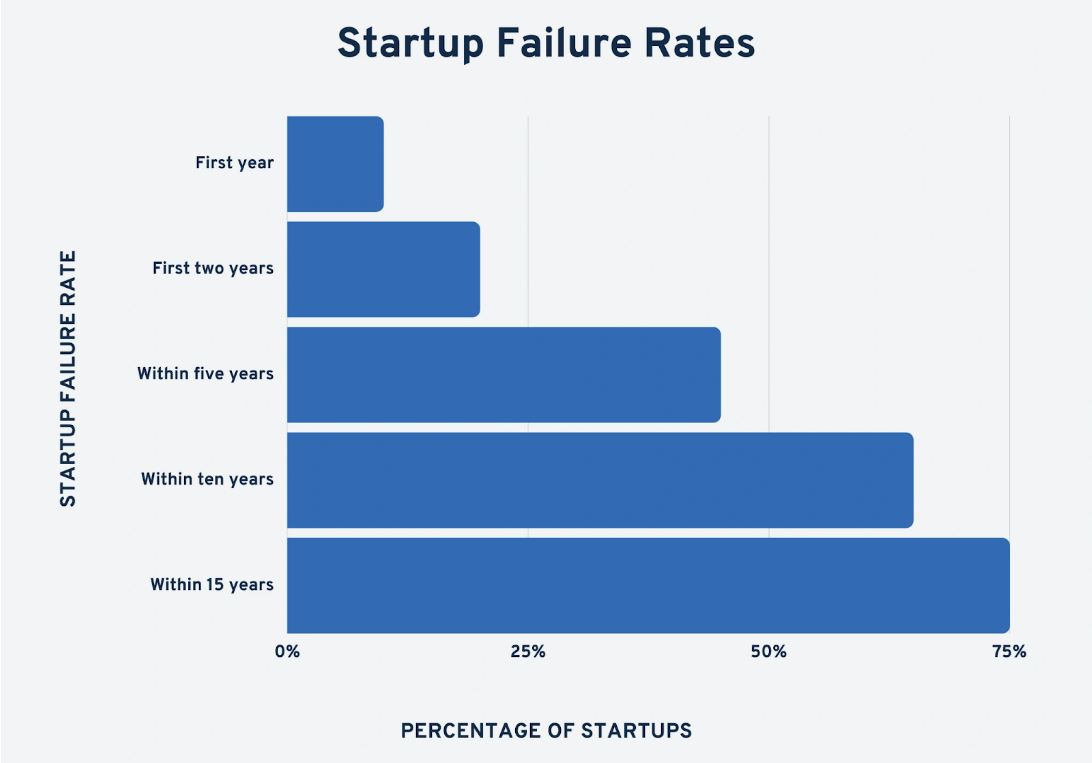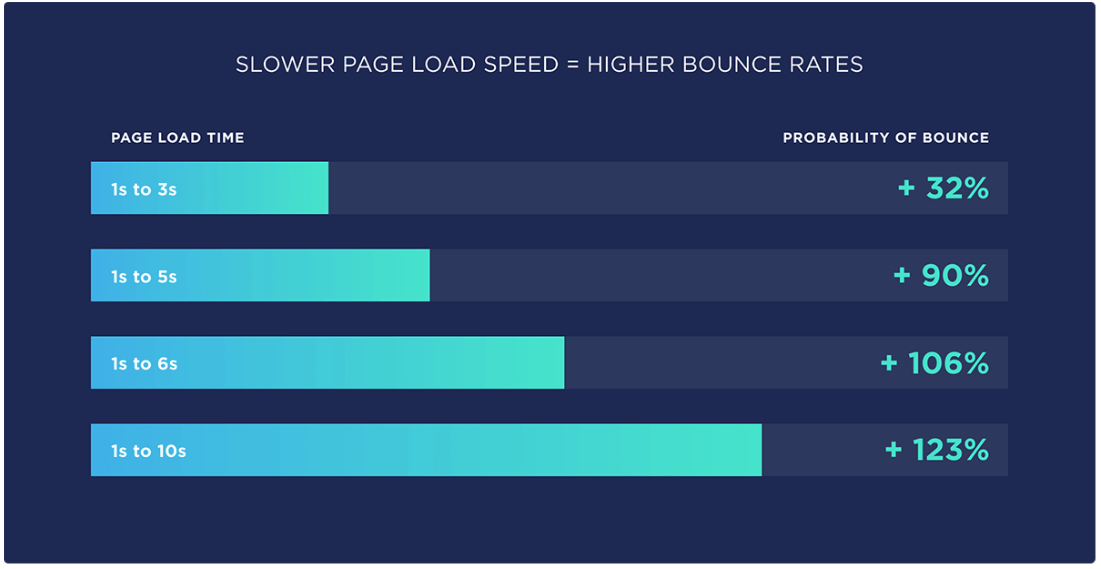Business expansion continues to become a more competitive process in 2022. On the back of inflation’s cash flow cuts and e-commerce’s skyrocketing success, entrepreneurs are constantly battling with the repercussions of post-pandemic recovery.
With a growth plan in mind, expansion strategies in 2022 will largely center around all things digital. With 4.6 billion social media consumers, and a whopping half of all e-commerce traffic now attributed to mobile devices, PR teams must start prioritizing their web-focused tactics if they want to expand in line with demographic trends.
In fact, a recent study from startups revealed that embracing technology was reported by 22% of business leaders as the greatest challenge in their expansion strategy.
(Image Source: Startups)
Alongside employee retention and increasing revenue, new demands for a digital revolution have left entrepreneurs with no choice but to move in line with online trends, if they still want to be profitable post-pandemic.
With 93 percent of all business purchase decisions starting with a search engine, it’s now essential to have a successful digital presence, ranging from a highly optimized website to an active social media platform.
The question is, just how many steps do you need to take to compete against the e-commerce giants dominating the playing field? Read on as we navigate the challenges of PR campaigning in 2022 and explore the new site-based must-haves entrepreneurs should consider in their growth plan for demographic success.
Incorporating a Best Web Hosting Platform into a PR team’s expansion strategy is essential for optimizing performance, ensuring security, and enhancing user engagement. By selecting a platform that aligns with their specific needs, PR teams can better execute campaigns, adapt to market changes, and ultimately achieve their growth objectives.
The challenges of business expansion in 2022
After 5.82 million entrepreneurs filed for small business status in 2021, the startup scene has never been so rich with competition. After a 3.5 percent spike in venture applications, company owners are working harder than ever before to expand amongst a sea of competitors.
On the back of a sharp increase in e-commerce retailing since the onset of the Covid-19 pandemic, SME leaders are facing a global labor shortage, higher operating costs and a new demographic demand for more personalization in a competitive market.
On the back of a consumer digital shift, e-commerce-based business ventures, in particular, are struggling to handle new levels of customer demand. With more internet users than ever before, automation has become the key ingredient for success. From website-based chatbots to scalable web hosting platforms, trained to respond quickly to an influx in consumer traffic, investing in all things technology has become a pricey affair.
(Image Source: Exploding Topics)
In fact, new statistics from Exploding Topics have revealed that half of all startups will now fail in their first five years of operation due to cash flow issues alone. Without the backup capital required to invest in widescale automation, smaller businesses are struggling to stay afloat.
The impacts of inflation
One factor in particular that continues to wreak havoc on the SME industry in 2022 is inflation. After the UK saw a new high of 9.4 percent in July, both consumer and company prices are rising as a result.
From a sharp increase in labor costs to supply chain and material expenditure, inflation has quickly topped the list of challenges facing entrepreneurs in a post-Covid landscape.
“High inflation is squeezing small business owners while many are still in a crucial recovery period,” states CEO of Simply Business, Alan Thomas. “The eye-watering cost of Covid-19 for SME owners, including lost work, earnings and loan repayments, now sits at a total of £109.6 billion according to one of our recent surveys.”
As VC funding pulls back and small business owners struggle to meet credit margins, SMEs are struggling to expand in this new financial climate, according to Thomas.
“One in six also believe they will never recover financially from the pandemic. As a result, two in five (46 percent) SMEs are calling for long-lasting financial support from the government to help them get back on their feet after Covid-19,” He claims.
Could your website be your source of success?
In an e-commerce-dominated environment, your website means everything when building your expansion strategy. With Google now receiving over 77,000 searches per second, you need to make sure you’re prioritizing your digital footprint if you want a shot at expansion success.
Did you know that nearly all web pages receive no organic traffic from any server? With over half of all clicks going to the first page of search results, having a poor-performing website could be adding to your downfall as a business.
In order to keep growing, it’s important to keep consumer engagement high, and content fresh as you battle your competitors for demographic attention. Not only do companies with optimised websites appear more authoritative within their industry, but they are twice as likely to be picked up by VC investors, and lead generation.
From SEO optimization to improving UX design, here are some of the small changes you could make for a large payoff in the SME industry.
Strong search engine optimization
Google’s algorithm takes over 200 different factors into account when ranking a webpage. From keyword use to blog writing efforts, prioritizing the SEO of your website is a low-cost expansion strategy with a large ROI payoff.
The key here is to get specific. Each new addition to your website should be both calculated and optimized for maximum conversion potential. From collating lists of high-performing keywords to simply optimizing the alt text of an image or video, the more time you spend tweaking the small details, the more efficient your site will become.
With a higher SEO ranking, your web page will appear further up the organic search string, increasing consumer engagement, company conversion rates and, in turn, business expansion.
In fact, over half of all marketers claim that organic search alone generates a larger return on investment than any other growth strategy.
Accessible UX/UI design
Another web-based factor business leaders should take into consideration is UX design. The user experience should be an entrepreneur’s top priority in a digital landscape. With so many websites, social pages and content to choose from, brands must work hard to provide customers with an accessible, streamlined experience when visiting their sites.
(Image Source: Backlinko)
For example, slow-loading websites can see a 32 percent bounce rate in just 1-3 seconds, according to Backlinko.
While investing in wide-scale automation, chatbots, and targeted paid content can be beneficial on the route to company growth, stepping back and prioritizing a simplified site design is essential if you want your consumers to engage with the content you put out there.
A reliable web host
Last but not least, investing in a reliable web hosting platform is crucial on the journey to company expansion, especially if you’re seeing a large influx in consumer traffic.
As the number of online users grows exponentially, websites must be prepared to handle an enhanced server bandwidth, data breach risks and a global consumer demographic.
Using web hosting services such as Hostinger to open up your company to a number of shared and private hosting options, you can quickly have more control over your site expansion. Not only can a web host improve scalability, enhance optimized content and provide a streamlined experience to high bandwidths of traffic, but they are also essential in the wake of a cyber security epidemic.
After cyber crimes increased by 600 percent in 2020 alone, data breaches have quickly become a risk for SME owners and a costly mistake for entrepreneurs that fail to protect their data. Web hosts keep your site secure and encrypted, allowing you to choose who you share your content with.
Coupled with the benefits of a streamlined UX design and keyword-focused content, company expansion could be just a few steps away as you see conversions skyrocketing.
A digital future
As we step into a new era of business expansion, entrepreneurs, PR professionals, and UX designers are looking at a digital tomorrow.
As campaigning for demographic attention becomes a digitally dominated competition, it’s time to start prioritizing your web-based strategy for ultimate engagement results. Brands that appear further up the organic search string will continue to rake in higher levels of revenue, and quickly appear as authoritative players in an e-commerce minefield.
Not only could a high SERP score gather more brand awareness, but it will transform campaign reach as the business continues to expand.






